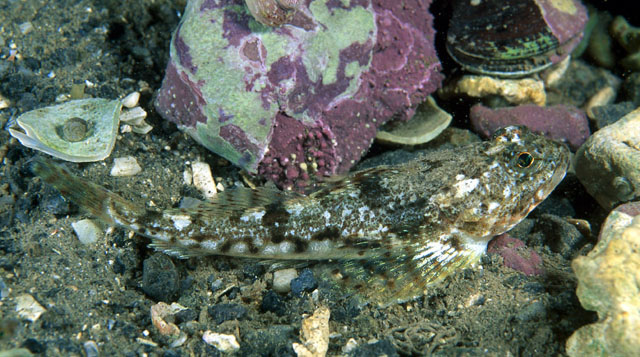| Cottidae (Sculpins) |
| 15.7 cm SL (male/unsexed) |
|
demersal; marine; depth range 0 - 930 m |
| Western Atlantic: Canadian Arctic to Hudson and Ungava bays and Newfoundland in Canada. Eastern Atlantic: Greenland, Iceland, Jan Mayen, Spitzbergen, Barents and Kara seas, Bohuslän in Norway (Ref. 4926). Reported from the Alaskan Beaufort Sea (Ref. 28503). |
|
Dorsal spines (total): 7-10; Dorsal soft rays (total): 17-23; Anal spines: 0-0; Anal soft rays: 12-17. Yellowish with brown spots, most numerous on back; narrow stripes on soft dorsal, pectoral and caudal fins, with dark spots on fin rays (Ref. 4698). Head height equal to head width. Males with a long pointed genital papilla (Ref. 35388). |
| Found on muddy, sandy or rocky bottoms or among algae (Ref. 4698). Maximum depth at 930 m (Ref. 58426). Benthic (Ref. 58426). Feeds on benthic polychaetes, crustaceans (Hyppolyte, Boreophausia), and large hyperiids (Phascolosoma) (Ref. 4698). Males usually below 7 cm and females below 12 cm. Lives at temperatures -1.7-10°C. Female lays 150-1,000 eggs with a diameter of 3mm (Ref. 35388). |
|
Not Evaluated (N.E.) Ref. (130435)
|
| harmless |
|
Occurs in the Alaskan Beaufort Sea, being widespread and abundant in the marine offshore waters, but also found in the brackish nearshore waters (Ref. 28503). Specimens cited by Evermann and Goldsborough 1907 (Ref. 11366) from Bristol Bay, Chignik Bay and Alitak Bay are outside the distributional range. Also Ref. 6876, 121277. |
Source and more info: www.fishbase.org. For personal, classroom, and other internal use only. Not for publication.

